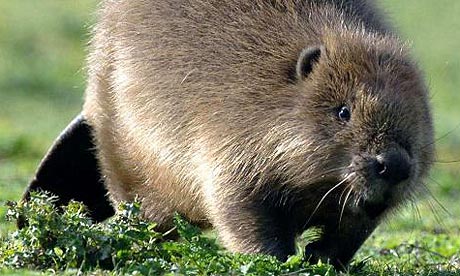I posted about the elusive beaver at the Frink Centre the other day and I think I will start with that... beavers! Now I am no beaver expert by any means, I have literally only seen one in real life ever (this past Saturday) but I do actually know quite a bit about them, having been a TA for winter ecology field trips several times.
 |
| I think they are soooo cute! (Photo credit: The Guardian) |
Beavers are rodents (not mammals) which is more obvious when you look at their two unique rodent-like front teeth. Beavers as far as I know are the largest rodents in Canada, (porcupines take a close-ish second), but I believe the Capybara (spelling?) is the biggest - we don't see those guys in North America though as far as I know. Beavers are semi-aquatic meaning they live both in the water and on land. Beaver's are pretty large. The one I saw on the weekend was very big, and I was quite a ways away from him. I have heard many people from around here saying it's not uncommon for a beaver to weigh over 50 lbs.
Beavers live in lodges, like the one seen below. The lodge is built in water, so the entrance inside is actually under the water but inside the lodge they live above the water. It can be -34 degrees C outside and still not below zero inside of a beaver lodge they insulate it so well. What I find really cute about beavers is that they often live in pairs and have families. I learned this in a documentary called "Dam Beavers" that I watched awhile back. In fact, inside their little family homes they often have two rooms, the first room is for drying of (shaking and smacking their tail once they come in from the water) and the second is the "living room". Too cute. Beavers have to store food over the winter as they don't actually hibernate. They have it a lot harder than muskrats, as muskrats can just eat plants that grow on the bottom of the pond. Beavers like trees like willow and alder, etc. and thus have to store the branches in their dens over the winter.
 |
| Beaver lodge at the frink centre, in Belleville ON |
One of the reasons people dislike beavers is their dam-building habits. The reason beavers build dams is because they actually can't find a good pond to build in, so they have to stop the flow of water. I don't know/remember the specifics to building dams but these beavers are incredible at it and it really is a fine art. Beavers used to be so abundant, especially in Canada, but there numbers are only a fraction of what they used to be. Hunting and habitat fragmentation are probably largely responsible for their decline.
These guys are really intelligent, amazing creatures and I hope that more people appreciate this and put effort into conserving their habitat and making co-habitation with humans possible.









.JPG)



